Exploring the Best Collins Glass: Functionality and Design
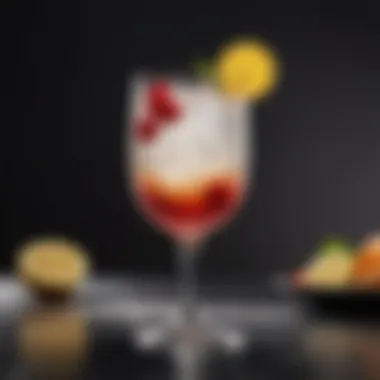
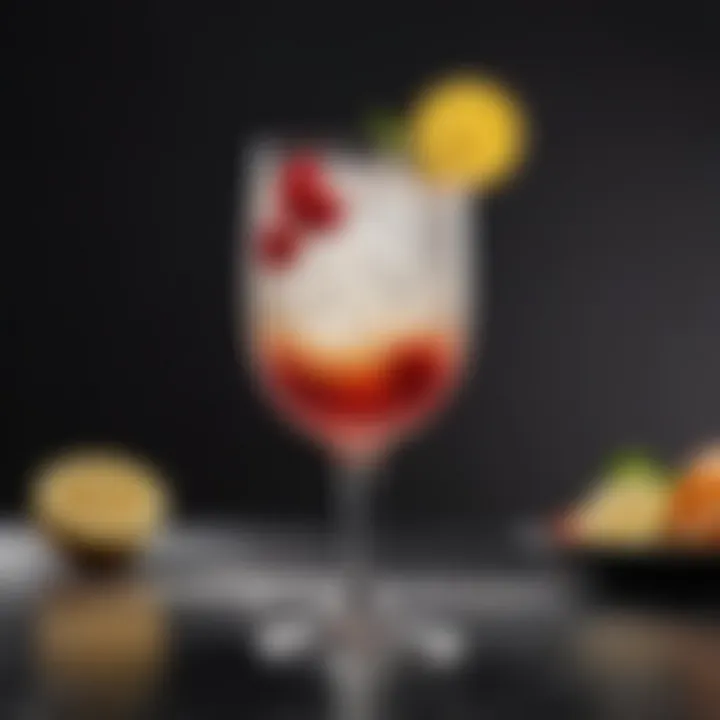
Intro
The Collins glass holds a significant place in the world of cocktails and mixology. Its tall, slender form is not only visually appealing but also practical for a variety of beverages. This glass is often associated with refreshing drinks, specifically those that require a tall serving vessel. As we explore the intricacies of the Collins glass, we will investigate its design features, functionality, and how it has evolved within contemporary cocktail culture. Understanding the nuances of this glass can enhance your overall drinking experience.
Design Attributes of the Collins Glass
The design of the Collins glass is integral to its appeal and functionality. Typically ranging from 10 to 14 ounces, this glass is taller and narrower than many other types, making it ideal for long drinks combined with soda or juice.
Key Features
- Dimensions: The standard height allows for a significant amount of ice, which is crucial for keeping drinks cold without diluting them too quickly.
- Material: Collins glasses are made from a variety of materials including glass, crystal, and even acrylic. Glass offers clarity and elegance while acrylic is more durable, often preferred for outdoor settings.
- Versatility: Its shape accommodates a range of beverages from gin and tonics to mocktails, showcasing the glass's adaptability.
"Choosing the right glass directly influences not only presentation but also the perception of taste."
Functionality in Beverage Service
Using a Collins glass can elevate the drinking experience in multiple ways. Its tall shape is designed for drinks stacked with ice, which promotes cooling. Additionally, the narrow top helps retain aromas, enhancing the sensory experience of drinking a cocktail.
Practical Considerations
- Ease of Handling: The slender design makes it easy to grasp, even when filled to the brim.
- Presentational Aspects: Aesthetics play a significant role in cocktail culture. The Collins glass complements garnishes beautifully, such as citrus slices or fresh herbs.
Relevance in Contemporary Cocktail Trends
As cocktail culture continues to evolve, the Collins glass remains a crucial component. Recent trends have seen a resurgence of classic cocktails and modern twists. Bartenders often return to the Collins glass for its ability to enhance both new and traditional recipes.
Popular Cocktails in Collins Glass
- Tom Collins
- Mojito Collins
- Strawberry Gin Fizz
This glass not only serves practical purposes but also aligns with mixology trends, often prompting creativity in drink presentations.
Finale
In summary, the Collins glass stands out not just because of its historical significance but also for its functionality and design. A thoughtful selection can transform the cocktail experience, making each sip more enjoyable. For enthusiasts and professionals, understanding these attributes is essential to mastering the art of mixology. Selecting a good Collins glass may well be the first step in elevating your cocktail presentations.
Understanding Collins Glass
The Collins glass holds a significant place in the world of mixology. Understanding its unique characteristics and functionality provides valuable insights not only for enthusiasts but also for professionals in the beverage industry. This section elaborates on historical significance, key definitions, and the driving purpose behind the design of the Collins glass.
Historical Context
The Collins glass has roots that trace back several centuries. It is believed to be named after a cocktail known as the Tom Collins, which gained popularity in the 19th century. This glass became the standard for serving tall mixed drinks. The design initially catered to the needs of the cocktails being served at the time. Over the years, it evolved alongside cocktail culture, adopting varied design elements but maintaining its tall, slim profile. This historical context underlines its role in the development of drinks, helping to define how cocktails are enjoyed today.
Traces of the Collins glass can often be found in literature and art related to bars and taverns from the late 1800s. Its purpose was not merely function, but also to play a part in the ritual of drink preparation and serving.
What Defines a Collins Glass?
A Collins glass is easily identifiable by its tall and narrow stature, typically measuring about 10 to 14 ounces in capacity. This specific design is optimized for cocktails that are served over ice and often topped with a soda or tonic water. A true Collins glass is made of glass, though some variants may exist in other materials. It usually features a straight body with a slightly tapered shape at the top, making it easy to hold and visually appealing.
Key aspects that define a Collins glass include:
- Capacity: Generally, it holds between 10 to 14 ounces of liquid, ideal for mixed cocktails that require space for ice and garnish.
- Tall Profile: The height enhances the visual appeal and serves functional purposes, allowing aeration and mixability of beverage ingredients.
- Material: Most Collins glasses are crafted from glass, which is essential for providing clarity and elegance, as it showcases the colorful layers of cocktails.
The Collins glass is more than just a receptacle for drinks; it embodies a specific style of drinking that informs both the preparation and presentation of cocktails. Its role in enhancing the drinking experience cannot be understated.
Material Choices for Collins Glasses
The choice of material for a Collins glass significantly impacts not only its aesthetic appeal but also its practical functionality. This aspect is crucial when selecting the ideal glass for cocktails. Different materials come with varied benefits and considerations, shaping the overall drinking experience.
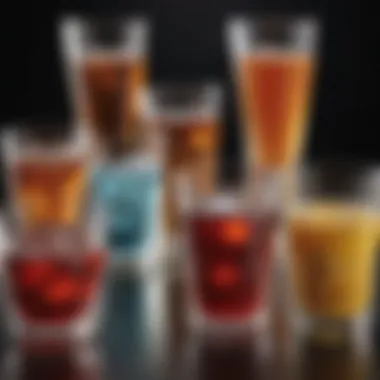
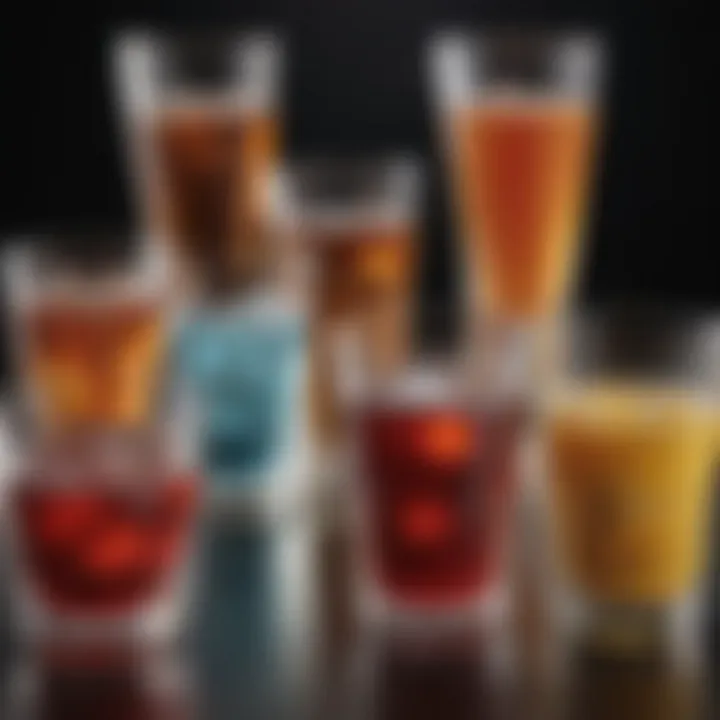
Glass vs. Plastic
Glass Collins glasses are the traditional choice. They offer a level of clarity and elegance that enhances the presentation of drinks. Glass is non-porous, meaning it does not absorb flavors or odors, allowing each cocktail to shine in its intended form. The weight of glass also conveys quality, providing a satisfying heft in hand. Furthermore, glass can endure higher temperatures, making it suitable for cocktails that incorporate heated ingredients.
On the other hand, plastic Collins glasses present a different set of advantages. They are lightweight, making them easy to handle, especially in casual settings or outdoor events. Plastic is also less prone to breaking, offering a practical solution for places where shattering could be a concern, such as by the pool or at picnics. However, plastic may not convey the same quality. Over time, plastic can scratch and develop a cloudy appearance, potentially affecting the visual appeal of cocktails.
Ultimately, the choice between glass and plastic hinges on context. If hosting a sophisticated gathering, glass is likely the best option. For a summer party, plastic could be more suitable due to its durability.
Crystal Collins Glasses
Crystal Collins glasses elevate the cocktail experience through their shimmering appearance and intricate designs. Made from fine crystal, these glasses reflect light beautifully, adding an element of luxury to any setting. They are often more fragile than traditional glass, requiring careful handling and storage.
One of the primary benefits of crystal is its ability to retain cold temperatures longer, ideal for drinks served on ice. Crystal also typically possesses a thicker rim, enhancing the drinking experience by providing a more substantial feel on the lips. The craftsmanship in crystal glasses often results in unique patterns or etchings, which can make each piece a conversation starter.
However, the price point for crystal Collins glasses tends to be higher due to the quality of materials and craftsmanship involved. This investment can be worthwhile for those who appreciate the finer things in life and seek to impress guests with a more sophisticated presentation.
"Choosing the right material is essential for not just aesthetic but also practical reasons. Each material brings its own advantages, catering to different needs and tastes."
Design Features
The design of a Collins glass is not merely an aesthetic choice but serves functional roles that enhance both usage and experience. A well-considered design can offer benefits in handling, serving, and even in the visual appeal of the cocktails served within. Understanding these design features is essential for anyone looking to elevate their cocktail experience, whether for personal enjoyment or professional service.
Shape and Size Considerations
The distinctive shape of the Collins glass is one of the first things that stands out. Typically taller than a traditional tumbler, the Collins glass is slender and elongated. This design allows for more ice to be added, maintaining the chill of the drink for longer periods. The height of the glass also facilitates layered drinks and garnishes, creating visually appealing presentations.
When it comes to size, most Collins glasses hold approximately 10 to 14 ounces. The size strikes a balance, providing ample capacity for mixed drinks yet remaining easy to handle. A larger glass allows for more complex cocktails, filled with fruit slices or herbs, adding depth both in flavor and presentation. Consideration should also be given to the ergonomics of the glass; a comfortably fitting rim and a weight that feels balanced in the hand contribute to an overall enjoyable drinking experience.
Color and Embellishments
The color and embellishments of a Collins glass can greatly impact the perception of the drink it holds. While many Collins glasses come in standard clear glass, various colors and designs are available. Colored glass can enhance the aesthetic appeal and set a mood that corresponds with the drink. For instance, a rich amber glass might evoke warmth and richness, aligning well with a bourbon-based cocktail.
Embellishments such as engravings, patterns, or even textured surfaces can add a personal touch. Some manufacturers offer bespoke designs, allowing for customization that caters to specific tastes or events. Beyond mere aesthetics, these elements often serve practical functions, such as providing better grip or enhancing light refraction.
"The right design not only enhances the visual appeal of a cocktail but also optimizes its functionality for an enjoyable experience."
Functional Aspects of Collins Glass
The functional aspects of Collins glass are critical to understanding its role in mixology and cocktail culture. This section explores how design attributes, usability, and performance contribute to an enjoyable drinking experience. For both enthusiasts and professionals, these elements are fundamental in selecting the ideal glassware, ensuring that each cocktail is served in the right context and presentation.
Ergonomics in Design
When it comes to Collins glass, ergonomics play a significant role. The shape is designed to fit comfortably in the hand, allowing for an easy grip while enjoying beverages. The height of the glass—usually around ten to fourteen ounces—offers a unique advantage. It provides ample surface area for cocktails garnished with herbs or citrus, enhancing both presentation and flavor.
A well-designed Collins glass should feel balanced. The center of gravity should be low enough to prevent tipping. This design ensures that even when the glass is filled with ice and liquid, it remains stable. This is particularly important in lively settings like bars or parties, where accidental spills can detract from the experience.
Innovative features, like a widened mouth, can also improve the overall functionality. This design allows for better aeration of drinks, which is especially beneficial for cocktails that require mingling of flavors, such as the Tom Collins.
Optimal Beverage Serving Sizes
Assessing the optimal serving sizes is also crucial when using a Collins glass. Typically, a standard serving in a Collins glass is around eight to ten ounces. This range balances the need for ample liquid volume while maintaining a visually appealing drink presentation.
The design of the glass encourages the inclusion of layers and garnishes. For example, cocktails that utilize soda or tonic can be served in larger quantities without overwhelming the drinker. This aspect amplifies flavor complexity and aesthetic appeal. Each cocktail served should also take into consideration potential garnishes which may take up additional space.
In addition, it's notable that the Collins glass typically serves drinks that are mixed with a base spirit and topped with soda or other mixers. This characteristic reinforces the tradition of using the glass for refreshing, longer drinks. Each drink served can highlight unique flavor combinations and can be adjusted for personal preference, solidifying the Collins glass as a versatile choice in cocktail presentation.
Popular Cocktails Served in Collins Glass
The Collins glass plays a vital role in the world of mixology, especially when it comes to classic and contemporary cocktails. The shape, size, and overall aesthetic of the Collins glass enhance the drinking experience, making it essential for serving specific cocktails. Whether one is creating a timeless drink or experimenting with modern flavors, the selection of cocktails served in a Collins glass merits special attention. Explore how the cocktails perfected in this glass elevate not only the flavors but also the presentation.
Classic Recipes

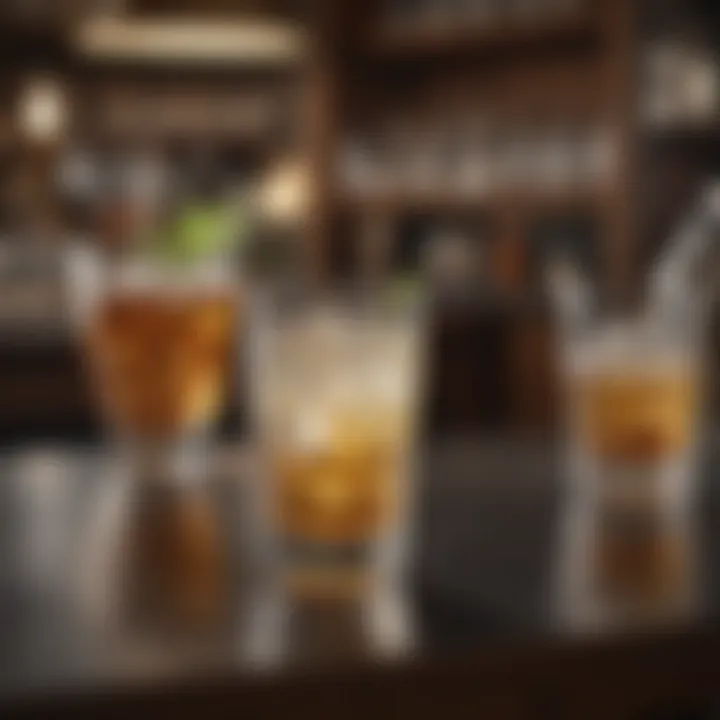
Tom Collins
The Tom Collins is a quintessential cocktail made with gin, lemon juice, sugar, and soda water. This drink is particularly significant as it showcases the Collins glass's capacity to blend simplicity with refreshment. A key characteristic of the Tom Collins is its balance of acidity from the lemon and the sweetness from the sugar, which make it a favorable choice for many. Its unique feature lies in the effervescence brought by the soda, creating a revitalizing experience, especially in warmer months. The advantages of serving a Tom Collins in a proper Collins glass are that it allows an ample amount of ice to chill the drink without diluting it too quickly. However, one disadvantage could be that some enthusiasts may find the drink overly sweet depending on personal taste preferences.
John Collins
The John Collins is a variation of the Tom Collins, typically made with bourbon instead of gin. This shift in base spirit lends a different profile, rich with warmth and robust flavor. The key characteristic of the John Collins is its depth, considered by some to bring a more complex sweetness compared to its gin counterpart. It is beneficial for this article to highlight, as it appeals to whiskey lovers and showcases the versatility of the cocktail scene. A notable feature of John Collins is its ability to remain refreshing even with the substitution of a stronger spirit. The downside to consider is that its stronger flavor might not appeal to those who prefer lighter drinks, making it a more niche choice for some.
Contemporary Variations
Sparkling Collins
The Sparkling Collins is a modern twist on the classic recipes, incorporating fizz with a variety of sparkling wines or flavored sparkling waters in place of traditional soda. This cocktail remains relevant by appealing to current trends that favor lighter and more effervescent drinks. A key characteristic of the Sparkling Collins is its refreshing quality, vibrant flavors, and the ability to cater to those exploring lower-alcohol options. What makes this variation advantageous is its versatility; one can infuse seasonal fruits or herbs to create unique cocktails. However, relying on sparkling alternatives may lead to inconsistency in recipes if the base flavor varies significantly.
Fruit-Infused Collins
The Fruit-Infused Collins emphasizes creative expressions that allow bartenders to customize their drinks with fresh fruits or flavored syrups. This contemporary take appeals to health-conscious drinkers and those seeking more natural flavors. The primary attraction of a Fruit-Infused Collins is its freshness, as the natural sugars and acids from fruits bring a delightful twist. It fosters experimentation, inviting drinks to reflect seasonal ingredients or personal tastes. One consideration for this cocktail, however, is that if not prepared properly, over-infusing the drink can overpower the original flavors, losing the classic touch of a Collins-style drink.
Brand Insights
Understanding brand insights is crucial for anyone interested in selecting the right Collins glass. The choice of manufacturer can influence not only the aesthetics of the glass but also its functionality and overall quality. Consumers often seek out brands with established reputations, which brings confidence in their product choices.
When it comes to Collins glasses, brand reputation reflects the commitment to craftsmanship and attention to detail. A reputable brand uses high-quality materials that ensure durability and enhance the drinking experience. Furthermore, trusted manufacturers often have better customer service and warranties, adding another layer of assurance.
Brand insights also encompass the unique design philosophies each manufacturer employs. Some brands might focus on contemporary aesthetics, while others prioritize classic designs. This allows consumers to select a glass that resonates with their personal style and preferences. In a world where presentation plays a significant role in dining and cocktail service, the brand chosen can greatly impact the visual appeal of the drink.
Top Manufacturers of Collins Glasses
Several manufacturers have carved out a prominent place in the market for Collins glasses. Notable names include:
- Libbey: Known for their sturdy glassware and classic designs, Libbey offers a wide range of Collins glasses. Their products are often favored for both home use and professional settings.
- Riedel: This brand is celebrated for its high-quality crystal glassware. Riedel's Collins glasses often feature elegant designs, making them suitable for special occasions.
- Bormioli Rocco: This Italian manufacturer is known for combining durability with style. Bormioli Rocco glasses often feature unique designs that stand out in any collection.
- Schott Zwiesel: Known for their Tritan crystal, Schott Zwiesel offers a modern take on traditional glass designs. Their products are designed to be both visually stunning and break-resistant.
Each of these brands brings something distinctive to the table. When choosing a Collins glass, it is essential to consider what each brand represents in terms of quality, design, and usability.
Comparative Analysis of Brands
Conducting a comparative analysis of brands can help in making an informed decision. Here are some factors to consider:
- Material Quality: Assess whether the glass is made from regular glass, crystal, or a specialized material. For example, Riedel’s crystal offers a refined look and feel, but might not be as durable as Libbey’s glasses.
- Design Language: Evaluate the aesthetic appeal. Some consumers prefer sleek and modern designs, while others may lean towards traditional styles.
- Price Point: Consider budget constraints. Brands like Libbey provide affordable options, while Riedel and Schott Zwiesel may have higher price tags due to premium materials.
- User Reviews: Analyzing customer feedback can lend insight into the long-term satisfaction with a product. Brands that consistently receive positive reviews indicate reliability and trustworthiness.
- Product Variety: A wider variety of styles and functionalities offered by a brand could be beneficial. A manufacturer like Bormioli Rocco may offer unique shapes, appealing to those looking for something distinct.
In choosing the right Collins glass, understanding brand reputation and product details can significantly enhance one’s selection.
Caring for Collins Glass
Taking proper care of your Collins glass is essential for maintaining its beauty and functionality. A well-cared-for Collins glass not only serves its purpose better but also reflects on the enthusiast's appreciation for mixology. Proper care extends the lifespan of the glass, ensuring that it remains a staple in your cocktail collection.
Cleaning and Maintenance Tips
Cleaning your Collins glass requires attention to detail, as the materials can vary. Here are some practical suggestions:
- Hand Wash Only: It is often best to hand wash your Collins glasses. The high heat from dishwashers can cause damage or warping.
- Use Mild Detergents: Opt for gentle dish soaps to avoid scratching or dulling the surface of the glass. Harsh chemicals can ruin the glass’s finish.
- Avoid Abrasive Sponges: Utilize soft sponges or cloths, which prevent scratches. An abrasive pad can leave lasting marks, diminishing the glass's visual appeal.
- Rinse Thoroughly: After washing, make sure no soap residue remains. Any leftover soap can affect the taste of drinks served later.
- Dry with Care: Use a non-abrasive drying cloth. This also helps in preventing water spots which can detract from the glass's clarity.
Following these tips will keep your Collins glass looking as splendid as the cocktails it holds.
Storage Considerations
Proper storage is crucial for ensuring that your Collins glass remains pristine over time. Here are some best practices:
- Store Upright: Keeping the glass upright helps to prevent scratches and removes risk of dust accumulation inside.
- Avoid Stacking: If possible, do not stack your Collins glasses. Stacking can lead to chipping or cracking.
- Use Protective Liners: If you must store glasses together, place a soft cloth between them for added protection.
- Cool, Dry Place: Store glasses away from extremes in temperature and humidity. This helps to prevent stress fractures in the glass material.
- Visibility: Organize your collection so that your glasses are easily visible without having to move others around.
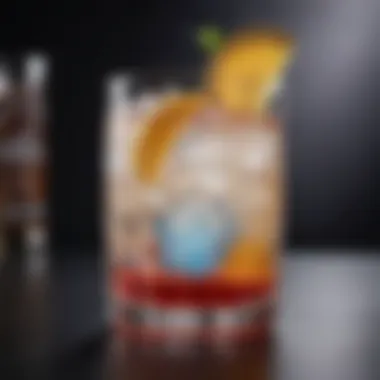
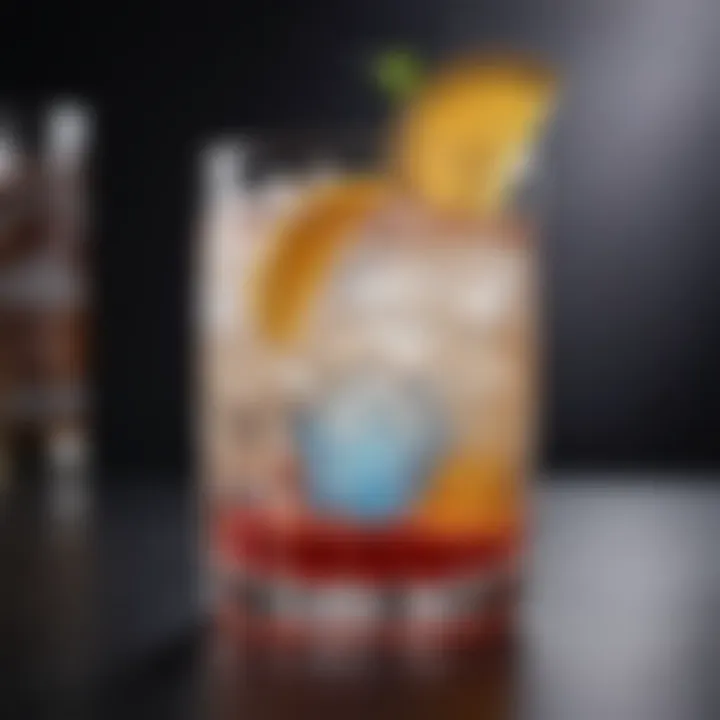
Following these storage tips contributes to the longevity and aesthetic of your Collins glass, allowing you to enjoy your cocktails for years to come.
"Caring for your Collins glass is an investment in your mixology experience. A well-maintained glass enhances both presentation and enjoyment of cocktails."
By adopting proper cleaning and storage practices, cocktail enthusiasts can ensure that their Collins glass will remain a cherished asset in their drinkware collection.
Collins Glass in Popular Culture
The Collins glass holds a notable place in popular culture, especially within the realm of mixology. Its presence extends beyond mere functionality; it represents a connection to social traditions and the enjoyment of crafted beverages. Many enthusiasts and casual drinkers alike appreciate how the Collins glass has evolved alongside cocktail culture, influencing both visual presentation and drink experience.
Representation in Media
The significance of the Collins glass in media is profound. It is often depicted in films, television, and literature as the glass of choice for refreshing cocktails. For instance, various popular TV shows feature characters enjoying a Tom Collins on a sunny patio, symbolizing relaxation and leisure. A notable example is its appearance in the classic film "The Thin Man," where a Collins glass embodies sophistication and charm. Such portrayals contribute to its status as an icon of the cocktail scene.
Moreover, imagery associated with Collins glasses aids in branding for many drink recipes. The aesthetic appeal that a well-crafted Collins glass brings to drinks can amplify its attractiveness to consumers. Scenes in media that highlight the glass often enhance the allure of the cocktails served within them, making the drink seem more enticing and desirable.
Collins Glass as a Symbol in Mixology
In the world of mixology, the Collins glass is not just a receptacle for drinks; it symbolizes a commitment to cocktail culture. Its tall and slender shape is ideal for cocktails that benefit from garnishes and ice, such as the refreshing Tom Collins, which is known for its aromatic botanicals and citrus flavors. The glass serves as a canvas, allowing bartenders to showcase their craft beautifully.
"The Collins glass epitomizes the blend of utility and artistry in cocktail preparation."
The innovation seen in modern cocktails has firmly established the Collins glass's place in bars worldwide. As drinks become more sophisticated, the choice of glassware, including the Collins, affects the overall drinking experience. The glass itself conveys a sense of elegance and attention to detail, reinforcing the idea that every aspect of a drink— from crafting to presentation— matters.
In addition, with the rise of social media, the Collins glass garners attention on platforms like Instagram and Facebook. Its photogenic quality makes it a favorite among social media users, further entrenching its status in contemporary culture. As people document their experiences with food and drink, the visual impact of the Collins glass continues to play a vital role in the narration of the cocktail journey.
Trends in Cocktail Serving
Analyzing trends in cocktail serving is crucial for understanding the evolving landscape of mixology. The Collins glass, with its tall and slender shape, has become a vessel of choice for many contemporary cocktails. The rising trend of craft cocktails has significantly shaped the way drinks are mixed and presented. This section will unpack how the resurgence of bespoke beverages centers on innovative use of Collins glasses.
Craft Cocktails and the Collins Glass
Craft cocktails draw inspiration from classic recipes while emphasizing artisanal methods and quality ingredients. The Collins glass serves a significant role in this movement. Its dimensions allow for ample mixing space and presentation for ice and garnishes, which are essential in craft cocktail creations.
Popular craft cocktails in Collins glasses include the Lavender Collins and the Elderflower Collins. These drinks showcase not only flavor but also visual appeal, supporting the idea that presentation is as important as taste.
- Visual Appeal: The elongated shape enhances the beauty of layered drinks and the vibrant colors of fresh ingredients. A well-made cocktail in a Collins glass can be a feast for the eyes.
- Drink Characteristics: These cocktails often utilize a mix of fresh herbs, fruits, and syrups, requiring a glass that can accommodate the varied textures and layers while providing an enjoyable drinking experience.
- Cultural Significance: The craft cocktail movement aligns with a broader appreciation for sustainability and locally sourced ingredients. Collins glasses, when made from crystal or high-quality glass, reflect this ethos and appeal to consumers interested in sustainable choices.
In summary, the Collins glass symbolizes the craft cocktail movement, marrying functionality with artistry to create an optimal drinking experience.
Influence of Social Media on Trends
Social media has become a significant driving force in the world of cocktails, deeply impacting how trends emerge, evolve, and dissolve. Platforms like Instagram and Facebook promote visual storytelling, making aesthetics a priority in cocktail presentation.
- Visual Sharing: Drinks served in Collins glasses often find their way onto social media feeds. The tall shape allows for creativity in garnishing and layering, enticing users to showcase their creations. This promotes not only the drink but the glass itself, leading to a wider appreciation of the Collins design.
- Trends Cycle Rapidly: As consumers share their experiences, trends in cocktail recipes can shift swiftly. A drink that garners attention on an influencer's page may result in a surge of popularity for Collins glasses as the preferred serving vessel.
- Community Engagement: Social media has brought together cocktail enthusiasts around the globe. Discussions and trends can be tracked through hashtags, fostering a community that shares recipes, techniques, and glassware preferences.
"The way cocktails are served and perceived can be heavily influenced by their representation in social media. The Collins glass has become not just a tool for serving but a canvas for artistic expression within the cocktail community."
As the cocktail culture continues to grow and change, the influence of social media and the prominence of the Collins glass will likely persist, shaping the consumer's palate and presentation preferences.
Finale
The conclusion of this article serves as a vital point of reflection on the Collins glass, bringing together various insights discussed throughout. It emphasizes the blend of functionality and design that characterizes this essential barware. Recognizing the significance of the Collins glass is important. This is not merely a vessel; it is a bridge between the art of mixology and the enjoyment of cocktails.
Summary of Key Points
In summary, the article covered several important aspects:
- The historical evolution that led to the creation of the Collins glass.
- Material choices, highlighting the differences between glass and plastic, and the allure of crystal glasses.
- Design features including shape, size, color, and uniqueness of embellishments.
- The crucial ergonomic aspects that enhance the experience when used.
- Popular cocktails that highlight the glass's versatility, ranging from classic recipes to contemporary variations.
- Insights into various brands and the care required for maintaining a Collins glass.
- The role of this glass in popular culture and its representation in media.
- Emerging trends relating to cocktail serving and the influence of social media.
Final Thoughts on Selection
When it comes to selecting the ideal Collins glass, several considerations come into play. The choice should align with both practical and aesthetic preferences. Factors such as the intended use—whether for professional mixology or casual entertaining—can guide this decision. In addition, factors like durability, style, and size significantly impact the user experience. A well-chosen Collins glass not only enhances the visual appeal of a cocktail but also underscores the thoughtfulness behind the presentation of drinks.
"The perfect Collins glass encapsulates the essence of a good drink, transforming an ordinary cocktail moment into a memorable experience."
As you explore options in the market, prioritize what resonates with your style. The right selection can elevate your cocktail service, making each sip an event of its own.







